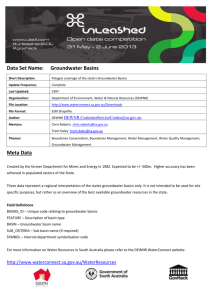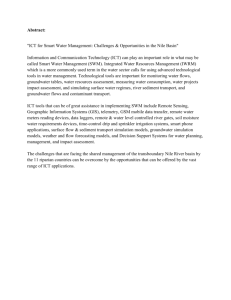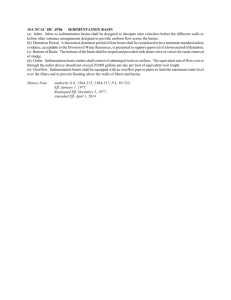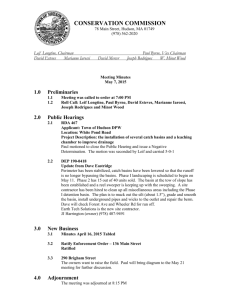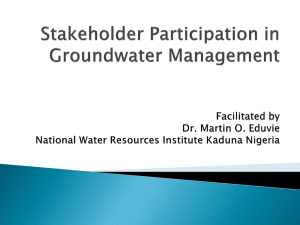Presentation report of ADB Report Summary
advertisement
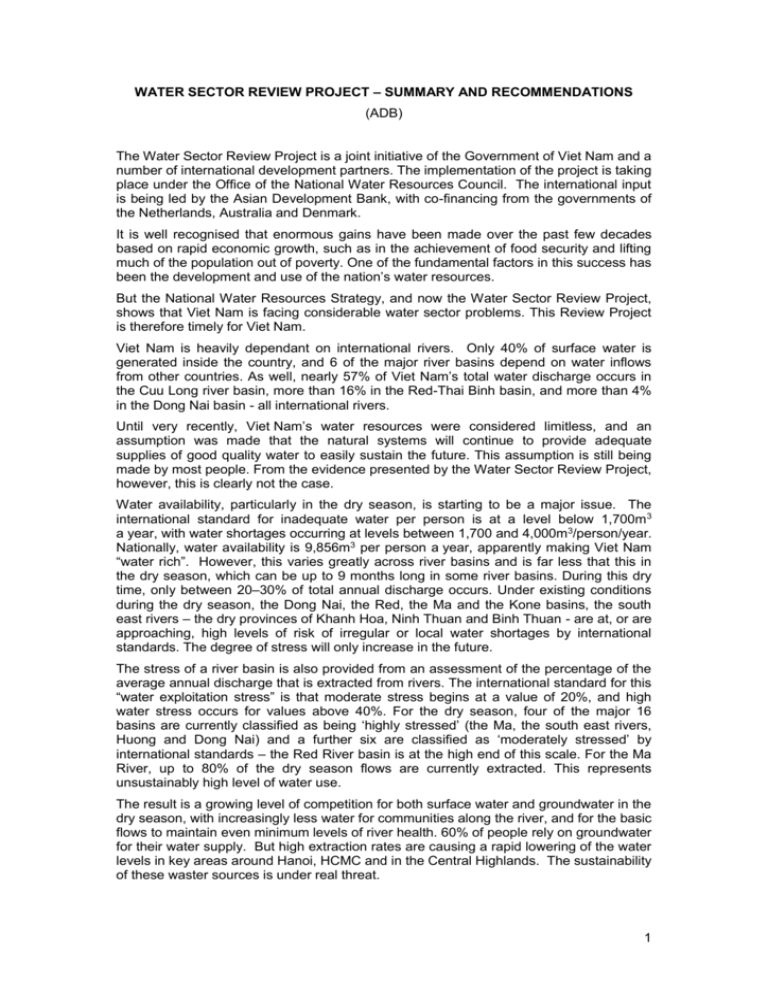
WATER SECTOR REVIEW PROJECT – SUMMARY AND RECOMMENDATIONS (ADB) The Water Sector Review Project is a joint initiative of the Government of Viet Nam and a number of international development partners. The implementation of the project is taking place under the Office of the National Water Resources Council. The international input is being led by the Asian Development Bank, with co-financing from the governments of the Netherlands, Australia and Denmark. It is well recognised that enormous gains have been made over the past few decades based on rapid economic growth, such as in the achievement of food security and lifting much of the population out of poverty. One of the fundamental factors in this success has been the development and use of the nation’s water resources. But the National Water Resources Strategy, and now the Water Sector Review Project, shows that Viet Nam is facing considerable water sector problems. This Review Project is therefore timely for Viet Nam. Viet Nam is heavily dependant on international rivers. Only 40% of surface water is generated inside the country, and 6 of the major river basins depend on water inflows from other countries. As well, nearly 57% of Viet Nam’s total water discharge occurs in the Cuu Long river basin, more than 16% in the Red-Thai Binh basin, and more than 4% in the Dong Nai basin - all international rivers. Until very recently, Viet Nam’s water resources were considered limitless, and an assumption was made that the natural systems will continue to provide adequate supplies of good quality water to easily sustain the future. This assumption is still being made by most people. From the evidence presented by the Water Sector Review Project, however, this is clearly not the case. Water availability, particularly in the dry season, is starting to be a major issue. The international standard for inadequate water per person is at a level below 1,700m 3 a year, with water shortages occurring at levels between 1,700 and 4,000m3/person/year. Nationally, water availability is 9,856m3 per person a year, apparently making Viet Nam “water rich”. However, this varies greatly across river basins and is far less that this in the dry season, which can be up to 9 months long in some river basins. During this dry time, only between 20–30% of total annual discharge occurs. Under existing conditions during the dry season, the Dong Nai, the Red, the Ma and the Kone basins, the south east rivers – the dry provinces of Khanh Hoa, Ninh Thuan and Binh Thuan - are at, or are approaching, high levels of risk of irregular or local water shortages by international standards. The degree of stress will only increase in the future. The stress of a river basin is also provided from an assessment of the percentage of the average annual discharge that is extracted from rivers. The international standard for this “water exploitation stress” is that moderate stress begins at a value of 20%, and high water stress occurs for values above 40%. For the dry season, four of the major 16 basins are currently classified as being ‘highly stressed’ (the Ma, the south east rivers, Huong and Dong Nai) and a further six are classified as ‘moderately stressed’ by international standards – the Red River basin is at the high end of this scale. For the Ma River, up to 80% of the dry season flows are currently extracted. This represents unsustainably high level of water use. The result is a growing level of competition for both surface water and groundwater in the dry season, with increasingly less water for communities along the river, and for the basic flows to maintain even minimum levels of river health. 60% of people rely on groundwater for their water supply. But high extraction rates are causing a rapid lowering of the water levels in key areas around Hanoi, HCMC and in the Central Highlands. The sustainability of these waster sources is under real threat. 1 As well, the quality of these rivers and groundwater sources is deteriorating rapidly as a result of a vast range of both land and water based developments and activities. The natural systems that depend on water, and in many cases that keep rivers and groundwater systems in a healthy state, are being increasingly affected by pollution and changes to the natural flows. Recently a growing number of major industrial establishments have been identified which are seriously polluting our waterways. Provision of water services is also poor. Around 8.5 million urban people do not have access to clean water and for those that do have supply, the current standard of service is very poor by international standards. In rural water supply and sanitation, despite the great recent efforts, 21 million people still do not have access to a hygienic water supply, and 41 people million do not have a supply that meets MoH clean water standards. The vast majority of rural people do not have access to a hygienic latrine. Irrigation has long been the pillar of the rural community. Water supply for growing paddy rice is at the very core of most rural communities. However, irrigation today has become more a means of providing social support, than a progressive and developing industry. Irrigation supply is inefficient, its infrastructure is old and dilapidated, totally reliant on state budgets and ODA to keep the systems going. At current funding levels - irrigation water is provided free of charge - all systems are progressively deteriorating and some will eventually be non-viable in part or full. Viet Nam is one of the most hazard-prone countries in the world. The fact that about 50% of its population lives on the coast compounds the problem. More than 80% of the population live at risk of direct impacts from natural hazards. In 10 years from 1997 to 2006, natural disasters caused over 5,000 deaths, and destroyed more than 6,000 fishing boats, nearly 300,000 houses, 4 million hectares of paddy rice, with a total damage cost of over 50,000 billion VND These reasons show why this Water Sector Review Project is important. The goal of the Water Sector Review is to help the Government and its development partners to adopt better approaches to water resources management. These new approaches will be based on the principles of “integrated water resources management”, or “IWRM” as it is commonly called, and will be in line with the objectives of the National Water Resources Strategy. Better water sector management will lead to far greater contributions of the sector to poverty reduction and sustainable national development. The main objective of the Project is to establish a common framework to guide development decisions in the sector and to help the Government's meet of the objectives of the National Water Resources Strategy in partnership with the international development partners, over the coming 10-years. The framework will be consistent with the adoption of IWRM initiatives. To do this, the Project has proposed a shared vision on the future directions of the water sector among different government agencies and other stakeholders, including priorities to address issues at the National, river basin and provincial levels. The overall goal for the effective management of the water sector is proposed as: To manage, use and protect the water resources of Viet Nam in an integrated and comprehensive manner to ensure that economic growth, poverty reduction, environmental health and the quality of life are sustainable in accordance with the goals of the Government. In order to achieve this goal, the following is required. 1. Strengthen the system of legislation, policies, and strategies on water resources The framework for IWRM at the national level, including water resources laws, institutional arrangements, National strategies and their implementation plans, and national policy positions, need strengthening. This will provide a basis for IWRM management generally, and to support activities at regional, river basin or provincial 2 levels. Without a strong and consistent framework, decisions and management will be ad-hoc with different provinces applying different approaches to deal with the same issue. Therefore, the following recommendations are proposed: A stronger legal framework Urgently revise the Law on Water Resources. Provide greater support to the implementation of the Law on Environmental Protection, with a water resource focus. Establish a clear legal basis for river basin management. Develop a legal framework for dealing with contaminated sites. Strengthen the legal arrangements for inland navigation. A stronger institutional framework Strengthen the role of the NWRC through a stronger legal base, setting up mechanisms under the NWRC for lower level coordination, etc. Establish the appropriate institutional model for river basin organisations. Create a management environment that encourages private sector involvement while protecting Viet Nam’s community interests in water. Further strengthen institutional arrangements for the provision of water supply and sanitation services. Further strengthen instructional arrangements for dealing with natural hazards and disasters. Strengthen other institutional arrangements (eg SOE equitisation, for overall craft village management, water resource planning institutions). Develop comprehensive national strategies on water and related resources management. A strong National policy framework completed Develop process/methodology for determining the “real potential” of water resources (surface and groundwater) as required by the Law. Develop a “water rights” and water sharing framework. Develop an environmental flows framework and methodology and establishing river operation rules. Develop process and methodology for undertaking river basin planning. Develop a national policy on water sector financing. Ensure greater coordination of investments by international development partners. Develop an "intact rivers" and a riparian zone policy approach. Stronger international cooperation Strengthen overall IWRM co-operative mechanisms with neighbouring countries, including at the sub-sector level, within the Mekong initiative, and new co-operative mechanism with other countries. 2. Improve the social environment and living conditions for people, especially the poor (including social empowerment of the poor) The fundamental GoV initiatives for improving health, living conditions and opportunities of the rural poor including ethnic minorities, must receive greater support from the water sector. This covers food security for the vulnerable, maximising opportunities for women and minority groups, pro-poor infrastructure development, ensuring basic water infrastructure for the poor and the implementation of the NTP II, minimising the effects of natural hazards, and sharing the benefits of major development with the people directly affected. Therefore the following recommendations are proposed: Ensure food security A strategic approach for rural development, focusing on diversification of rural enterprises. Identify and protect good agricultural lands to ensure security of continued food production. Social equity Mainstream gender / ethnic equity in all aspects of water management. Adopt the “benefit sharing” concept to assist vulnerable communities (especially in hydropower development). Ensure vital Prepare standards for RRWS ensuring that those applicable for rural 3 infrastructure for poor people are not inappropriately lower than those for urban people. Strengthen the implementation of NPT II on a wide range of fronts. Incorporate IWRM concepts into the NTP II. Better deal with natural hazards Prepare natural hazard protection plans for the highest priority river basins (Huong, Tra Khuc, Thu Bon & Vu Gia, Kone). Progressively prepare natural hazard protection plans for other basins. Apply other non-structural measures to protect against natural hazards, such as community preparedness and response strategies. Apply structural measures to protect against natural hazards. 3. Effective management and sustainable use of water resources The sustainable development and use of water for all purposes must continue to support the economic growth of the country. To provide the sustainable development framework requires the preparation of river basin and groundwater plans, the construction of infrastructure (urban and rural) for economic development, and the application of IWRM measures for water extraction and use (eg issuing licences for exploitation and ensuring compliance, pricing, monitoring water use, etc). Therefore, the following recommendations are proposed: Prepare river basin plans for priority areas Urgently prepare water sharing component plans for highest priority river basins (Red, Dong Nai (including the South East rivers), Thu Bon, Ma, Huong, Ba, Kone). Prepare water sharing plans for additional basins with significant hydropower development (Se San, Sre Pok, Ca). Progressively prepare water sharing plans for the remaining river basins. Urgently prepare aquifer sharing plans for priority groundwater areas requiring the management of water extractions (Red River delta, HCMC aquifer, Mekong delta, Central Highlands, Hai Phong, Ba Ria Vung Tau, Vinh City, Quang Nam Province, Thanh Hoa Province, Ben Tre Province, Soc Trang Province). Prepare framework plans for other priority groundwater areas so as to set priorities for more detailed planning. Water sector infrastructure to support economic growth Ensure that all future reservoirs, particular for hydropower, provide maximum benefits to the community. Maximise the contribution of irrigation infrastructure, by increasing efficiency. Ensure the structural safety of existing major dams on which so much economic development depends. Urgently provide additional infrastructure development for urban water supply, particularly for cities/towns under district control. Strengthen IWRM tools Fairly apply water fees and charges in order to provide a basis for sustainable service delivery. Significantly upgrade the licensing of water extractions at the local level as a basis for more effective management of water extraction. Use demand/supply management measures to manage competition for water. Monitoring water extraction and use. Protect important water supply sources from inappropriate devleopments. 4. Water related biodiversity conserved, pollution prevented and environmental quality improved In order to protect water related biodiversity, prevent pollution and improve environmental quality a wide range of activities are required. These include preparing river basin and groundwater plans to protect environmental health, protecting water related biodiversity, the construction of urban infrastructure for environmental improvements, IWRM 4 measures for water health protection and preventing pollution (issuing licences for wastewater discharge and compliance, fees and charges, EIA, etc), and measures for protecting Viet Nam’s important water related environmental assets (eg wetlands, national parks, conservation forests). Therefore, the following recommendations are proposed: Prepare river basin plans for water source protection Urgently prepare water source protection component plans for the Dong Nai Basin. Progressively prepare water source protection plans for other river basins with priority set through a risk assessment process. Prepare water source protection plans for groundwater sources with priority set through a risk assessment process. Prepare protection and management plans for water related environmental assets such as major wetland areas. Infrastructure development for environmental improvement Urgently increase infrastructure for urban sanitation services. Urgently increase infrastructure for the treatment of hospital effluent. Ensure that all existing and future industrial zones meet the wastewater discharge standards or licence conditions set by MoNRE. Develop a strategic plan for the management of the environmental effects of craft villages. IWRM tools for water source protection Improve the effectiveness of EIA and environmental protection commitments. Better management of the environmental effects of river structures. Establish community environmental values and objectives as a basis for managing water related impacts. Establish and maintain a register of polluting and impacting activities. Significantly upgrade the licensing of wastewater discharge at the local level as a basis for reducing pollution. Make greater use of fair economic measures for water source protection. Reform and strengthen the implementation of Decision 64. Introduction of Environmental Management Systems to minimise the effect of operational activities on the environment 5. Institutional capacity strengthened There is an urgent need to greatly enhance the existing capacity of the Government agencies, and the community, for more effective application of IWRM concepts. This requires activities in two distinct areas. Firstly, strengthening the ability of the GoV organisations to carry out their water resources work more effectively and efficiently (eg by providing the basic water resource information for good decisions, by providing the right skills and resources). Secondly, building the capacity of the community to participate, providing means for their participation, and mobilising the considerable resources and energy of the community to achieve good IWRM outcomes. Therefore, the following recommendations are proposed: Ensure highquality and timely water data and information Implement a National data and information management programme and provide access to all. Develop a National water data and information programme for climate change. Strengthen the application of legal documents for the management of water resources data sets. Prepare a National Water Research plan. Donors should ensure that project documents and working papers are easily accessible. Intuitional capacity Enhance capacity at all levels by identifying capacity development needs for IWRM and an implementation programme. 5 strengthened Enhance appropriate decision support tools (including models). Provide a stronger basis for more effective sub-sector management by developing and implementing sub-sector benchmarking. Strengthen compliance through a review of current compliance activities and prepare a strategic compliance improvement plan. Strengthen community and water user involvement Strengthen the involvement of farmers in decision making by strategically reviewing progress and preparing a win-win situation for the government and farmers. Increase community awareness by developing and implementing water education programs. Increase community participation through river basin panning processes and through innovative programmes such as “streamwatch”. Urgent priorities In terms of strengthening the system of legislation, policies, and strategies on water resources, the immediate priorities are: (i) Revision of the Law on Water Resources, (ii) Establishing stronger arrangements for the operation of the National Water Resources Council, (iii) Prepare the MoNRE’ strategic plan to implement the Water Resources Strategy, (iv) establishing a legal basis and implementation framework for river basin management to achieve IWRM, (v) Develop process and methodology for determining the “real potential” of water sources, (vi) Develop a water rights and sharing framework, (vii) Develop an environmental flows framework and methodology, and (viii) Develop national policy on water sector financing. In relation to improving the social environment and living conditions for people, especially the poor, the immediate priorities are: (i) MARD to prepare a strategic approach to selecting priorities for pro-poor rural development and irrigation diversification, (ii) MoH to prepare uniform and appropriate standard for both water supply and sanitation (rural and urban) (iii) Greatly strengthen the implementation of NPT II, and (iv) Prepare natural hazard management plans for the highest priority river basins (Huong, Tra Khuc, Thu Bon & Vu Gia and Kone). In relation to the effective management and sustainable use of water resources, the immediate priorities are: (i) Prepare water sharing component plans for highest priority river basins (Dong Nai, Red, Thu Bon and Ma), (ii) Prepare aquifer sharing plans for priority groundwater areas requiring the management of water extractions (Red River delta aquifer, aquifer around HCMC, central highlands), (iii) Prepare framework plans for areas with significant hydropower development, (iv) Review all proposals for further reservoir/inter-basin diversion against agreed framework and water sharing plans, (v) Urgent infrastructure development for urban water supply, (vi) Programme to reduce unaccounted for water in urban areas, and (vii) Programme to increase water efficiency in irrigation areas. In relation to water related biodiversity conserved, pollution prevented and environmental quality improved, the immediate priorities are: (i) Water source protection plan for the Dong Nai basin, including Ba Ria-Vung Tau, (ii) Urgent infrastructure development for urban sanitation services, (iii) Urgent infrastructure for the treatment of hospital effluent, (iv) Establish community environmental values and objectives as a basis for environmental protection, (v) Develop further implementation guidelines for Decree 67 and lead capacity building, and (vi) Provide incentives for the more effective implementation of Decision 64. In relation to Institutional capacity strengthening, the immediate priorities are: (i) Urgently implement National water and related data and information management programmes, (ii) Develop a National water data and information programme for climate change, (iii) Enhance capacity at all levels for the implementation of IWRM approaches, (iv) Strengthen the involvement of farmers in irrigation scheme decision making, and (v) Implement a water education programs carefully targeted to community behaviour. 6

